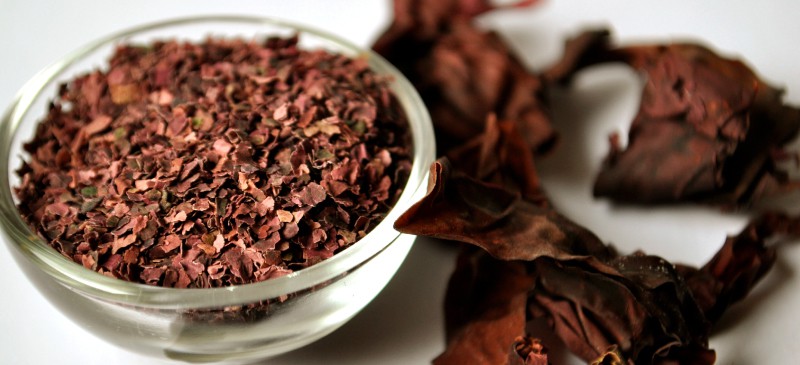
If you dislike the taste of seaweed but want to add a nutritional sea vegetable into your diet, then you’re in luck. Dulse, a seaweed that’s gaining popularity in culinary circles, tastes like — believe it or not — bacon.
Dulse has been harvested and consumed for over a thousand years, with early records of use in Scotland, among Christian monks. This rose-colored seaweed is known for its impressive nutrition content and unique flavor.
It can easily be added to everyday recipes and has even been used to make ice cream.
So next time you see a package of dulse at your local grocery store, give it a try!
What Is Dulse?
Dulse, or Palmaria palmata, is a type of edible seaweed with an impressive nutrition profile. It’s also called dillisk, dilsk, red dulse, sea lettuce flakes and creathnach. It’s rich in macro- and micronutrients, including protein, fiber and antioxidants.
It grows wild on the northern coasts of the Atlantic and Pacific Oceans and is harvested at the beginning of summer and fall seasons.
Dulse looks like a leafy, red lettuce when it’s fresh, although it’s hard to find the seaweed fresh because it’s usually dried immediately after harvest. When the seaweed is raw, it has a leathery texture, and the fonds, which grow from the root, vary in shape.
You can find dried, packaged dulse products in some grocery stores. It’s available in whole-leaf and flaked forms and can be purchased as a powder or in seasoning mix.
Along with its notable antioxidant and nutrient content, dulse is well-loved for its taste, which has been likened to that of bacon.
Nutrition
Dulse nutrition features both macronutrients and micronutrients, including dietary fiber, protein, iodine, B vitamins and potassium. There is no recommended serving size, but adding one to two tablespoons to recipes as a garnish or flavor enhancer is sure to provide a range of nutrients to your diet.
One five-gram serving of dulse flakes contains approximately:
- 13 calories
- 2 grams carbohydrates
- 1 gram protein
- 1 gram fiber
- 836 micrograms iodine (557 percent DV)
- 0.4 milligrams vitamin B6 (22 percent DV)
- 391 milligrams potassium (11 percent DV)
- 1.4 milligrams iron (8 percent DV)
Benefits
Dulse benefits health in the following ways:
1. Provides Iodine
Iodine is a vital nutrient that’s responsible for regulating thyroid function, supporting healthy metabolism and preventing certain chronic diseases. Because many adults do not consume enough iodine-rich foods, iodine deficiency is not uncommon.
Even a small serving of dulse contains over 100 percent of the daily recommended dose for iodine. Research shows that this benefits people with hypothyroidism because the nutrient is needed to make thyroxine, a key hormone for many important biochemical reactions in the body.
Iodine is also needed for healthy growth and development, brain function, and detoxification.
Keep in mind, consuming too much iodine is also problematic and can lead to thyroid disorders. People who have Hashimoto’s and thyroiditis should be careful with iodine consumption and eat foods very high in the nutrient sparingly.
2. Rich in Potassium
Potassium is an essential nutrient that plays a role in electrolyte balance and maintaining healthy fluids. It’s required for the function of several organs, including the brain and heart.
Studies show that healthy potassium levels reduce the risk of heart disease, protect bone health and support development.
Dulse seaweed is a good source of potassium and can easily be added to your diet as a garnish to help you maintain healthy levels of this important nutrient.
READ RELATED: Diego Maradona investigation hears carers crushed sleeping pills into his beer
3. Fights Inflammation
Eating this red seaweed is an excellent way to keep inflammation at bay. An animal study published in Food Research International found that anti-inflammatory components, including phycobiliproteins and chlorophyll, can be extracted from dulse and used to reduce acute inflammation and swelling.
4. Supports Metabolic Health
Like wakame seaweed, which is known to help fight diabetes, dulse may help support metabolic health when added to your diet. Research suggests that the bioactive compounds in dulse are linked to metabolic health improvements.
Algal polysaccharides help improve satiety and modulate gut microbiota, and protein peptides and phenolic fractions have anti-inflammatory, antioxidant and antidiabetic effects.
5. Works as an Antioxidant
Consuming foods with antioxidant compounds helps reduce oxidative stress in the body that can lead to several health issues. A 2020 study indicates that red alga dulse has a high antioxidant capacity and scavenging activity.
The amino acids extracted from the seaweed showed protective effects against UV-induced damage and potential anti-cancer properties.
6. Provides Plant-Based Protein
Dulse is one of the most protein-rich seaweeds out there, second to nori. Adding the red seaweed to your diet can help increase your protein intake, which is beneficial to cardiovascular health, maintaining a healthy weight and lowering inflammation.
Plant-based protein sources like dulse also provide dietary fiber, which helps regulate digestion and increases satiety.
How to Use
You can find dried dulse flakes in your local health food or grocery store. Dulse lasts quite a while, about two years, but you should store it in a cool, dark place.
Before using it in recipes, be sure that the flakes are free of shells and small particles that may be left over from harvest.
There is no dosage recommendation for dulse, but it’s considered safe to eat in normal food amounts. Adding it to recipes throughout the week will provide a range of nutrients, but don’t go overboard, as it’s very high in potassium and iodine.
You can eat raw dulse or cook it to add to recipes, like sandwiches, omelets and salads. It can be treated as a flavor enhancer or prepared alone as a snack, which is common in the Northeastern United States, Canada, Iceland and Ireland.
You can bake the flakes to make dulse chips or add flakes to salsa, soups, breads, pizza dough and meat dishes.
The seaweed flakes can be used as a garnish in many recipes by simple chopping them into pieces and sautéing with butter or olive oil until they are crisp. You can add the pieces into pasta dishes, salads, popcorn, tofu dishes, quiches, omelets and more. The crisp have a similar taste to bacon.
To reconstitute the dried flakes, simply add them to a bowl of warm water, and let them soak for five 10 minutes. You can then add them to vegetable dishes, stir-fries and seaweed salad.
To make dulse tea, let the leaves sit in simmering water for two to three minutes, and then strain them. Use stevia to add sweetness.
Risks and Side Effects
Dulse is considered safe when consumed in amounts found naturally in food.
People with kidney problems should not overeat dulse because it contains high levels of potassium that may be dangerous. It shouldn’t be consumed in large amounts by people with thyroid issues either, because of its iodine content.
If you’re consuming dulse to improve thyroid issues, do it under the care of your doctor or health care professional.
Women who are pregnant or breastfeeding can eat dulse in normal amounts but should not use the seaweed therapeutically unless doing so under the guidance of a health care professional.
Conclusion
- Dulse leaf, flakes and powder are made from the red seaweed that grows wild on the northern coasts of the Atlantic and Pacific Oceans. It’s typically harvested and dried for preservation.
- Dulse is rich in nutrients, especially iodine. It also contains protein, fiber, potassium, vitamin B6 and iron.
- Cooking with this nutritious seaweed is easy. It tastes a bit like bacon and can be added to many everyday recipes, including soups, breads, pizzas, salads and vegetable dishes.
Source:







